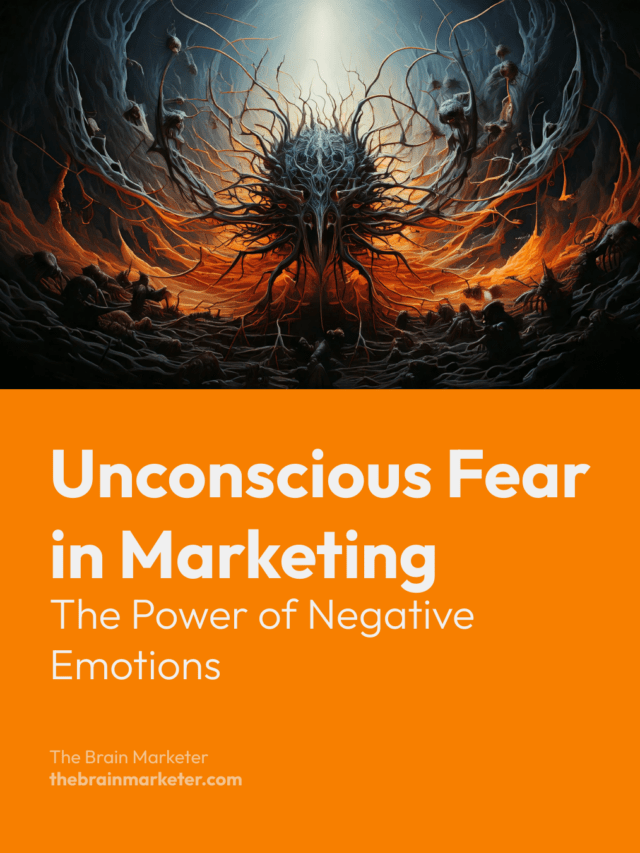Fear is one of the most powerful motivators in the human brain. While negative emotions are often avoided in everyday communication, they can become strategic assets in marketing when used subtly and ethically. Not all fear creates the same effect: it’s unconscious fear that embeds itself deeply into memory, driving consumer attention and brand recall.
This article explores how unconscious fear activates the primal brain, and how brands can use this mechanism to make their messages more memorable and impactful.
Key Takeaways
- Unconscious fear activates the primal brain, increasing focus and retention.
- The most powerful triggers involve fears of loss (money, control, energy).
- Successful campaigns stimulate fear without overwhelming the audience.
- The Coca-Cola insect ad shows how even discomfort can boost brand recall.
- Fear-based strategies must be used ethically, with the consumer’s trust in mind.
🎙️ Unpack the Topic with this Podcast
Unconscious Fear and the Brain’s Survival Response
The primal brain is wired to detect and respond to danger, even if it’s only perceived subconsciously. When fear is triggered, the body reacts with increased heart rate, adrenaline and focused attention. This heightened state boosts memory retention, as the brain prioritizes information that might be linked to a potential threat.
In marketing, unconscious fear can be used to capture attention without causing distress. When the viewer isn’t fully aware of the trigger, their primal brain still reacts leading to stronger engagement and recall.
Case Study: Coca-Cola’s Insect Commercial
A memorable example is Coca-Cola’s “insect ad”, where insects (a common fear trigger) appear in scenes paired with Coca-Cola branding. Though subtle, the fear response activates a fight-or-flight reaction, increasing focus and information retention.
Results:
- The ad had a 50% recall rate, compared to 10% for typical commercials.
- Viewers often remembered the ad without knowing why.
The subconscious discomfort created a lasting imprint in memory, demonstrating how fear can enhance message retention even when the emotional reaction isn’t positive.
The Primal Brain’s Three Core Fears
Fear works best when it taps into deep, evolutionary concerns. The primal brain is especially alert to three types of perceived loss, all tied to basic survival instincts:
1. Fear of Financial Loss
This is one of the most frequently triggered fears in advertising. It appeals to our instinct to preserve resources and avoid unexpected risks.
Example: Insurance and fintech brands use scenarios involving accidents or emergencies to highlight the need for financial protection, subtly motivating consumers to take preventive action.
2. Fear of Losing Control
Autonomy is a core psychological need. When people feel overwhelmed or disorganized, they experience discomfort rooted in the fear of losing control.
Example: Apps and services that enhance productivity, manage schedules or monitor health tap into this fear, offering users the promise of order and stability.
3. Fear of Wasting Energy or Effort
From an evolutionary standpoint, conserving energy was key to survival. Today, this translates into a strong preference for convenience and ease.
Example: Brands that offer time-saving gadgets, automation tools or streamlined user experiences appeal to our desire to minimize unnecessary effort.
When these primal fears are activated subtly and ethically, they can significantly increase attention, emotional relevance and message retention.
Why This Strategy Works (When Used Ethically)
Fear works because it targets the brain’s survival logic. Unconscious fear amplifies attention and primes the brain to remember what’s being presented. But there’s a fine line: overly frightening or manipulative messaging can backfire, damaging trust.
The goal is to stimulate the fear response subtly, making the viewer more receptive without triggering resistance.
Conclusion: The Subtle Art of Fear in Advertising
Fear doesn’t have to be loud to be effective. When used with precision, unconscious fear captures attention, improves memory encoding and increases message salience.
Brands that successfully use this tool (like Coca-Cola with its insect ad) balance emotional tension with a clear message and positive brand association. In a crowded media landscape, this subtle use of fear can help ensure your message not only cuts through but sticks.
Source
- Öhman, A. (2005). The role of the amygdala in human fear: automatic detection of threat. Psychoneuroendocrinology.
- LeDoux, J. (2012). Rethinking the emotional brain. Neuron, 73(4), 653–676.
- Damasio, A. (1994). Descartes’ Error: Emotion, Reason, and the Human Brain. Avon Books.
- Coca-Cola “Insect” Commercial: A neuromarketing case used in attention & memory research.

Vincent Heimann is a marketing project manager and neuromarketing enthusiast. He founded The Brain Marketer to bridge neuroscience and marketing through accessible, science-based content. With over 10 years of experience in digital strategy, UX/UI and communication, he shares practical insights to help brands connect with the human brain — ethically and effectively

